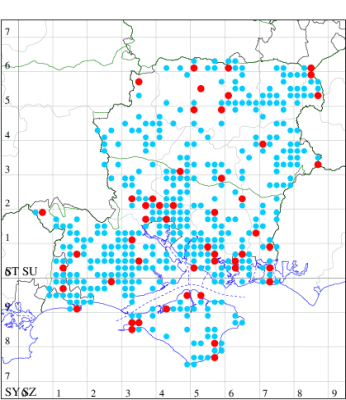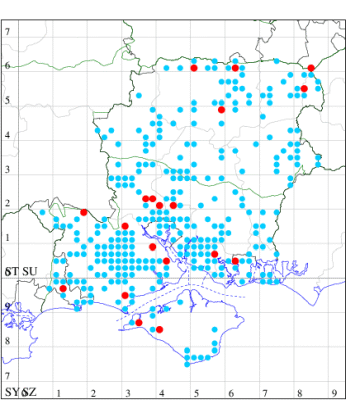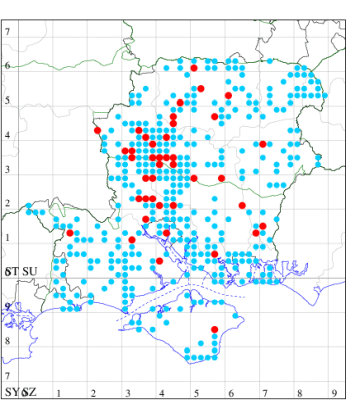2022 Annual Report for: Noctuidae / Amphipyrinae
For species seen in 2022 that had less than or equal to 100 records, full details are included; for more common species, the earliest, latest and highest count by vice-county are shown. The narrative for each species is taken from the main Hantsmoths website, and it is possible that some information on abundance and occurrence can get out of date, as it is impossible to keep up with all changes; however it should give a good introduction to each species. The tables in each species account summarise the previous status, and that for the current year.
For the maps, all records prior to 2022 are shown by a blue dot (the larger the dot, the more recent), with the current year's records shown in red. As previous records are superimposed on any report for 2022, new sites have greater emphasis (i.e. will show as 'more red').
In the species accounts, an asterisk next to a location indicates a new 10km square record; earliest ever dates are highlighted in orange, and latest ever in red. Initials in the species accounts refer to the recorders listed here. Please get in touch if you identify any omissions or errors, in particular if you have records that have yet to be submitted. Details of how to submit records can be found here.
73.062 [B&F: 2297] Copper Underwing Amphipyra pyramidea (Linnaeus, 1758) - Common
Common in woodland, scrub, hedgerows, gardens and parks throughout much of England, Wales and southern Scotland. In Hampshire and on the Isle of Wight widespread in deciduous woodland, and particularly common in the New Forest. Wingspan 47-54 mm. It has been proved empirically that the only safe way of separating this species as an adult from the closely related Svensson's Copper Underwing A. berbera is to view the underside of the hindwings - for which see the comparative image in the photo gallery.
In pyramidea the underside of the hindwing's discal area is a pale straw yellow which contrasts with the orange-copper shading of the terminal area. In berbera this discal area is suffused orange-copper in the dorsal half which continues to the termen.
Please indicate when submitting records that this check has been performed.
Larva feeds on Hawthorn, Midland Hawthorn, Blackthorn, Crab Apple, Hazel, Honeysuckle and Downy Birch, over-wintering as an egg.
Updated: July 2019 (comparison between species)
Records prior to 2022
| Vice County | #Records | #Individuals | First Record | Last Record |
|---|---|---|---|---|
| 10 | 437 | 724 | 1900 | 2021 |
| 11 | 3145 | 4560 | 200 | 2021 |
| 12 | 1113 | 1724 | 1951 | 2021 |
2022 records
| Vice County | #Records | #Individuals | Max Quantity |
|---|---|---|---|
| 10 | 30 | 51 | 5 |
| 11 | 87 | 98 | 3 |
| 12 | 49 | 61 | 3 |

Records by year
Records by week (adult)
Records by week (larval)
Record Summary
VC10: Earliest: Osborne Wood, 18 Jul, 2 (IOu) Latest: Shanklin, 25 Oct, 1 (IOu) Max count: Osborne Wood, 14 Sep, 5 (IOu)
VC11: Earliest: Hayling Island, 20 Jul, 1 (STho) Latest: Lovedean, 19 Oct, 1 (ARJ) Max count: Fareham, 24 Aug, 3 (MLO)
VC12: Earliest: Pamber Forest, 11 Jul, 1 (GJD) Latest: Hammer Vale, Woolmer, 05 Oct, 1 (ASwa) Max count: Basingstoke, 18 Jul, 3 (MJW)
73.063 [B&F: 2298] Svensson's Copper Underwing Amphipyra berbera Rungs, 1949 - Common
Common in woodland, scrub, hedgerows, gardens and parks throughout much of England, Wales and southern Scotland. In Hampshire and on the Isle of Wight distribution poorly known due to confusion with A. pyramidea, but there is, as yet, no conclusive evidence that either species is present in an area where the other is not. Wingspan 47-54 mm.
In pyramidea the underside of the hindwing's discal area is a pale straw yellow which contrasts with the orange-copper shading of the terminal area. In berbera this discal area is suffused orange-copper in the dorsal half which continues to the termen.
Please indicate when submitting records that this check has been performed.
Larva feeds on Pedunculate Oak, over-wintering as an egg.
Updated: July 2019 (comparison between species)
Records prior to 2022
| Vice County | #Records | #Individuals | First Record | Last Record |
|---|---|---|---|---|
| 10 | 61 | 66 | 1981 | 2021 |
| 11 | 1261 | 1544 | 1951 | 2021 |
| 12 | 426 | 583 | 1951 | 2021 |
2022 records
| Vice County | #Records | #Individuals | Max Quantity |
|---|---|---|---|
| 10 | 4 | 5 | 2 |
| 11 | 17 | 17 | 1 |
| 12 | 10 | 10 | 1 |

Records by year
Records by week (adult)
Records by week (larval)
Record Details
VC10: Freshwater, one, underside of hind-wing checked, 22 Sep; two, underside of hind-wing checked, 19 Sep; one, underside of hind-wing checked, 24 Sep; Mottistone Down*, one, underside of hind-wing checked, 12 Sep (PBar);
VC11: Hale Purlieu, NF, one, 17 Aug (JPuz); Marchwood, one, 27 Aug (CTha); Copythorne, one, very worn specimen, 23 Sep (JAda); Woodley, one, 31 Aug (NBin); Romsey, one, 10 Sep (NRJ); Buttsash, Hythe, one, 02 Sep (JBl); Vale Park, Chandler's Ford, one, 26 Aug; one, 28 Aug (KArb); Allbrook, one, 27 Aug; one, 23 Sep (SIng); Fareham, one, 20 Aug; one, 15 Sep (MLO); Portchester, one, 23 Aug (DH-J); Hurn, one, 27 Jul; one, 03 Oct (MJef); Pennington, one, 23 Aug (RFC);
VC12: Basingstoke, one, checked underside hindwing, 05 Aug; one, 21 Aug; one, 03 Sep; one, 19 Sep (GAH); Ecchinswell, one, found dead, hindwing underside checked, 12 Aug; one, indoors, hindwing underside checked, 16 Aug; one, hindwing underside checked, 28 Aug (MJN); Pamber Forest, one, 26 Jul (GJD); Fleet Pond, one, to sugar, singles checked until both species confirmed, then recorded as agg, 18 Jul (MHals); Blackwater*, one, sugaring, 13 Jul (BGD)
73.064 [B&F: 2299] Mouse Moth Amphipyra tragopoginis (Clerck, 1759) - Common
Common in a wide range of habitats, including gardens, woodland, sand-dunes, moorland and fens throughout the British Isles, more commonly recorded at sugar than at light and recent apparent declines may reflect this, a species of conservation concern under the UK Biodiversity Action Plan. Widespread and still moderately common in Hampshire and on the Isle of Wight. Wingspan 32-40 mm. There are usually three small dots on the forewing, and the moth is likened to a mouse in coloration and in the way it scampers into cover when exposed. Larva feeds on a wide range of herbaceous plants and shrubs, over-wintering as an egg.
Records prior to 2022
| Vice County | #Records | #Individuals | First Record | Last Record |
|---|---|---|---|---|
| 10 | 43 | 16 | 1951 | 2018 |
| 11 | 1399 | 2577 | 1951 | 2021 |
| 12 | 1189 | 1680 | 1951 | 2021 |
2022 records
| Vice County | #Records | #Individuals | Max Quantity |
|---|---|---|---|
| 10 | 1 | 1 | 1 |
| 11 | 27 | 30 | 3 |
| 12 | 74 | 102 | 5 |

Records by year
Records by week (adult)
Records by week (larval)
Record Summary
VC10: Earliest: Alverstone, 03 Jul, 1 (DFai) Max count: Alverstone, 03 Jul, 1 (DFai)
VC11: Earliest: Horndean, 02 Jul, 1 (PHog) Latest: Romsey, 25 Oct, 1 (NRJ) Max count: Crawley, 30 Jul, 3 (GCE)
VC12: Earliest: Morn Hill, Winchester, 09 Jul, 1 (CRB, DAS, PDF et al) Latest: North Waltham, 03 Oct, 1 (AJon) Max count: Crawley, 01 Aug, 5 (GCE)